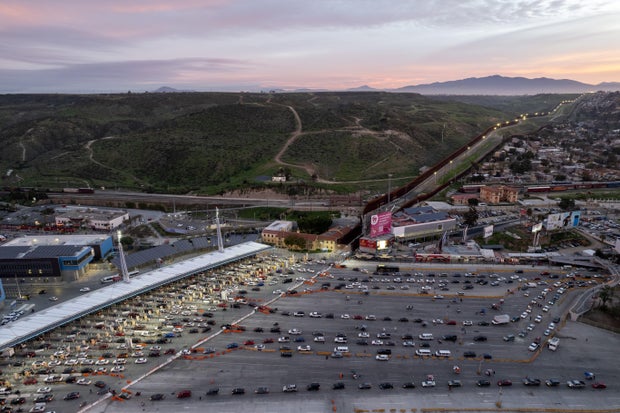President Biden is taking executive action on Tuesday to authorize U.S. immigration officials to deport large numbers of migrants without processing their asylum claims, the White House said, announcing what is arguably the most restrictive border policy by a Democratic president in recent history.
Mr. Biden’s aggressive move will suspend the processing of asylum claims between official entry points along the southern border, allowing U.S. authorities to more quickly reject and deport migrants who enter the country unlawfully, administration officials said in a call with reporters previewing the order. The president is set to speak at 2 p.m. at the White House.
The partial ban on asylum claims will take effect almost immediately, officials said. Regular asylum processing will only be restored 14 days after the secretary of homeland security determines that the weekly average of daily illegal border crossings has dipped below 1,500. The proclamation could be activated again if the weekly average of daily crossings between ports of entry surpasses 2,500.
To the dismay of migrant advocates, the seismic policy change will attempt to upend U.S. asylum law, which allows migrants on American soil to request humanitarian protection, even if they cross the border illegally. But Biden administration officials have argued the asylum system is buckling under the weight of over 3 million pending applications, incentivizing migrants to come to the U.S. because it takes years to decide their cases.
What Biden’s immigration order does
Mr. Biden is signing a proclamation temporarily suspending the entry of most migrants at the southern border, while the Departments of Justice and Homeland Security are publishing a regulation to implement his directive. The measures are set to take effect at midnight on Tuesday.
Migrants who cross the U.S.-Mexico border between legal entry points when the order is in effect will be barred from asylum and “immediately removable” to Mexico or their home countries, officials said. The administration, one official added, plans to carry out these deportations “in a matter of days, if not hours.”
Guillermo Arias/AFP via Getty Images
Only migrants who affirmatively express fear of being persecuted or tortured will be screened by U.S. asylum officers, the officials said. But they will only be screened for lesser-forms of protection — not asylum — and will need to pass interviews with heightened standards to avoid being quickly deported.
The asylum crackdown will not apply to unaccompanied children, those with acute medical conditions or fleeing imminent harm and migrants who use legal pathways to enter the U.S., such as the system powered by the government smart phone app known as CBP One. The administration will continue to process roughly 1,500 migrants at ports of entry under the CBP One process.
To justify the policy shift, the administration is citing a 1950s law known as 212(f) that empowers the president to suspend the entry of foreigners when the executive branch determines that their arrival is “detrimental” to U.S. interests. That same law became infamous under the Trump administration, which invoked it to sharply restrict legal and illegal immigration, including travel from certain Muslim-majority countries.
Officials said the partial asylum ban will apply to so-called extra-continental migrants, such as those from China, who have been journeying to the U.S. border in record numbers in recent years. But they did not say Mexico had agreed to take them back, raising the specter that some migrants will still be released with court notices since certain, including China, limit or reject U.S. deportations.
A major policy and political shift
Mr. Biden’s policy is modeled after one of the pillars of a bipartisan border security deal that failed twice in Congress due to widespread Republican opposition, giving administration officials an opportunity to argue they are acting unilaterally on one Americans’ top concerns in the absence of congressional action.
While sweeping in nature, the announcement will not completely “close” or “shut down” the southern border, as asylum processing and legal trade and travel will continue unimpeded at official ports of entry.
In many ways, Mr. Biden’s drastic border pivot stems from the intense political pressure he has faced from Republicans and some Democrats on immigration, one of his worst-polling issues.
But it is also in response to the reality on the ground along the U.S.-Mexico border, where American officials have reported record levels of migrant apprehensions, including over 2 million in each of the past two years. This year, migrant apprehensions are down by more than 50% from the all-time highs recorded late last year, partially due to a months-long campaign by Mexico to stop migrants from reaching the U.S. border.
One administration official said Tuesday’s announcement would “strengthen the asylum system, preventing it from being overwhelmed and backed up by those who do not have legitimate claims.”
Andrea Flores, a former Biden administration official, denounced the president’s move, saying it could set a dangerous precedent.
“If the president is now claiming he can shut down asylum when he feels like it – even after border numbers have plunged by over 50% — this precedent gives future presidents the pretext to suspend any immigration pathway to the United States,” Flores said.
Sara Cook contributed reporting.










































